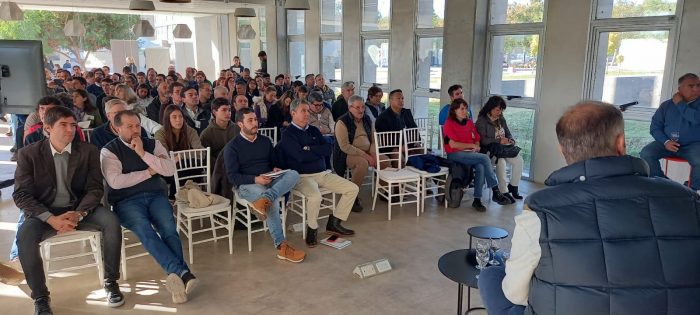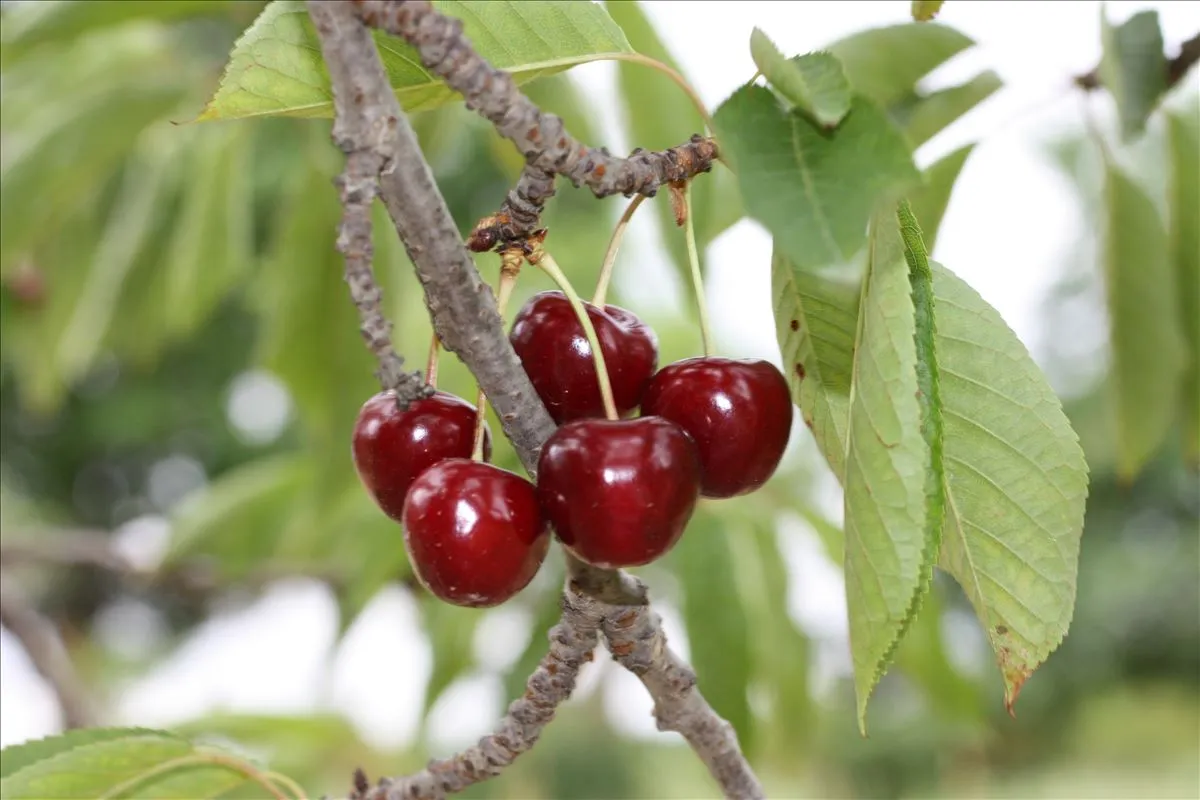Argentina is currently shipping the last cherries for export of the 2023/24 season. This year has been relatively good, with shipments of about 8,600 tons, a record volume, but with high costs and a depressed dollar. Additionally, there is always fear among local producers because Chile has virtually taken control of the entire business: they have sold 415,000 tons this season, fifty times more. "In other words, if they sneeze, they kick us out of the market."
Something similar had already happened to Argentina with blueberries. Shipments of this prized fruit were booming until about a decade ago when Peru began producing it in large quantities, competing with Argentina (and Chile) for the same off-season markets in the northern hemisphere. And since, thanks to its location on the world map, Peru produced the first harvest, there was no way to compete with it. The blueberry business halved.
With Chile next door, Argentine cherry producers face the same risk, but at least they have been warned. For this reason, a few days ago, at the Innovation Space of UNCuyo, about 120 people gathered for the third edition of the International Seminar on Early Cherries. It would have been just another boring technical meeting if the future of the sector were not at stake.
 Image 1: Third International Seminar on Early Cherries.
Image 1: Third International Seminar on Early Cherries.
The cherry dilemma was explained very clearly by Diego Aguilar, who works in a company that produces this fruit both in Mendoza and Santa Cruz, to have supplies available throughout the season, from the first days of November, when the harvest begins in Cuyo, until February, March, or even April, when supplies come from the south.
Aguilar is also currently the president of the Chamber of Cherries of Mendoza. He was interviewed on the program “Colonia Agropecuaria” on AM550.
 Image 2: Diego Aguilar.
Image 2: Diego Aguilar.
We are not a major player in the cherry market, right?
"No, we're not. We aspire to be, but we're not. At one point, we were. Mendoza, specifically, was the largest cherry exporter in the southern hemisphere, until our Chilean brothers arrived, capitalized on the business, and grew to exorbitant levels because they grew exponentially, and we still have the same production we had 20 or 25 years ago."
To the point that Chile already exports 50 times more than Argentina
"That's more or less the number. When you want to make a calculation, you can't understand it, but it's a significant amount of fruit being exported and obviously foreign currency entering the country. At least 1.2-1.3 billion dollars come in just from the export of one product. And we've stood still, we were the pioneers, and we've stood still."
And why is that?
"The blame is mostly on the country's political and economic ups and downs. The truth is that we've lost competitiveness because the cherry sector requires a lot of labor, and especially in Mendoza, viticulture was gaining ground and was seen as an alternative, and some crops were uprooted, leading to a decrease in cherry cultivation area. Now, little by little, this variable is improving; it grows very slowly despite our political and economic reality."
 Image 3.
Image 3.
Aguilar commented that this ending season has been quite positive, despite the fact that Mendoza had some problems with the zonda wind, and therefore, it was harvested in the midst of the change of government and economic policy. Much of the fruit harvested, in this context, ended up in a depressed domestic market, which did not always pay a good price. Exports, however, responded and met expectations. Fortunately, Chile has not sneezed yet.
“Cherries are one of the few fruits that do not go around the year. That is, from mid-April to May, there is a month when there is no fruit in the northern hemisphere. Obviously, there is no fruit here in Argentina either. Then, from September to October, there is no fruit either, so these are the two poles we have to attack," the grower indicated.
That's why the seminar organized by various institutions, including the Institute for Rural Development (IDR) of Mendoza, made a lot of sense: producers in this region are looking for a technological solution to enter the international market a few days earlier than most of the Chilean offer, thus having a differentiated activity, with a more stimulating price.
“It's possible with Mendoza's super-premium fruit. We have to harvest even before the first week of November, which is the norm, and try to get to October 20, which would lead to even better prices," Aguilar indicated.
The same idea, but with late varieties, is being experimented with in the Los Antiguos valley in Santa Cruz, several hundred kilometers further south. There, according to the director of cherry growers, it would be necessary to “extend the season as much as possible to be able to ship the fruits by ship and have them arrive in the first days of April”.
“We are members of CAPSI, which is the Argentine Chamber of Cherry Producers, but Mendoza has a very particular reality, being a province that is not part of Patagonia, we lack the comparative advantage that Patagonia has as a brand. The Patagonia brand sells and is highly sought after. So, we looked for differentiation and discovered that there was a niche market in early fruit”.
Where can this early cherry be produced?
This is particularly true in the northern part of Mendoza, in the Northern Oasis, which can make an early harvest starting from October 25 with little effort. This puts it in a privileged position among all the producers in the southern hemisphere, which are not many.
Even compared to Chile?
Also because it is difficult for Chile to achieve this earliness. They have some crops in the Ovalle area, which have been successful and excellent results in economic terms, but in terms of production, they can achieve very little. It is already a very marginal area, with little water, with little accumulation of winter cold. So the crop has to be forced, and working against nature is expensive.
Imagine growing it in Mendoza?
That's the goal of the seminar: to talk about the possibilities of Mendoza. It is possible to make these investments in Mendoza with less money and achieve better results.
Now... We're talking about advancing the harvest by a few days, just a couple of weeks.
"Yes, but in terms of marketing, they are fundamental, they are very important. From one day to the next, prices drop sharply. So we have to arrive as soon as possible, with the best possible quality. But the first 10-15 days are fundamental. From October 25 to November 10 is the window that remains open in Mendoza to make a difference".
Is it an effort of the private sector alone or does it require a plan with the support of the province or the national government?
"Public-private articulation for all this is fundamental. We find ourselves in the circumstance that Mendoza is free from the fruit fly only halfway, from the Uco Valley southward. The northern area is not. So the markets we can access with this fruit are those that do not have this requirement, those in the Middle East and the Far East, Singapore, Dubai, Qatar, the United Arab Emirates.
But there are protocols for other countries that we cannot comply with in northern Mendoza, and this is where we have to work to free the northern area from the scourge of the fruit fly".
This plan would also allow the conversion of many vineyards that are no longer profitable, is it possible?
"It's possible. The Rural Institute of Mendoza has worked on the minimum sustainable unit of about 7 hectares. A producer who has a 7-hectare cherry plantation can take care of it alone and can support his family very well, and he can also have the ability to save and grow".
"This is surprising in other countries. So this is a possibility for conversion. We are trying to convince some vine producers, whose prices have been very irregular lately, to return to the old scheme of having at least 5 hectares of cherries to be able to take advantage of the harvest".
What impact could this conversion have?
"It would significantly increase the cultivated area. Mendoza had 2,000 hectares of cherries, currently, we are at 700. The volume has not decreased because we produce with better quality. The idea would be to recover this area, to produce as we produce with the current productivity, and to seek new markets precisely in this privileged area".
"It's a beautiful and ambitious project that we've been working on for years. For us, it has been difficult to attract new investors because in the country, there is a certain degree of resentment and distrust".
Are you looking for foreign investors?
"The greatest success has been achieved by local producers, not from abroad, for now. Many people from Chile, the United States, and Colombia came to the event, interested in investing. We'll see what happens".
Otherwise, there is always the risk that Chile will surpass us, as it happened with blueberries
"I believe that our differentiation is that of Mendoza, with the early fruits and then with quality. This sets us apart from Chile, which does not have a domestic market to place the export scraps but has to send all the fruit it produces, and the yields are usually lower. So Argentine fruit is very well cataloged thanks to the separation we make between export and domestic market".
According to records, Mendoza has between 30 and 40 producers, mainly located in the Uco Valley and the Northern Oasis. Out of 700 hectares, practically half of the national cherry area, the province obtains about 5,000 tons of cherries destined for fresh consumption. Of this figure, 90% is destined for the markets of Buenos Aires, Rosario, and Cordoba, with excellent returns for early fruits, and 10% is exported. The south, on the other hand, focuses more on export activity.
Source: Bichos de campo
Images: Bichos de campo
Cherry Times - All rights reserved















